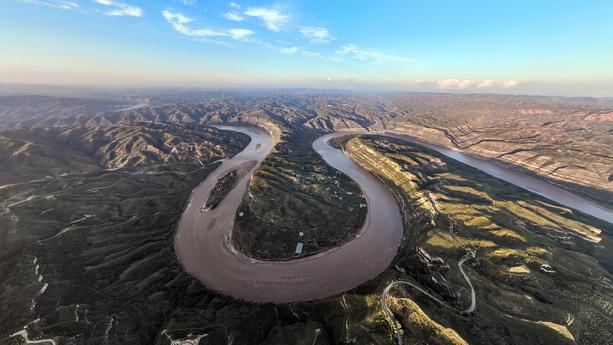New law to safeguard waterway, strengthen its governance
 (DENG GUOHUI / FOR CHINA DAILY)
(DENG GUOHUI / FOR CHINA DAILY)
China's top legislature passed the Yellow River Protection Law on Oct 30 to further enhance the waterway's governance and protection. The law will take effect on April 1.
This is good news for Zhang Fei, 40, who works in the Yellow River administration bureau in Kaifeng, Henan province, and has spent the past 17 years building and guarding embankments along a section of the river.
Zhang's grandfather and uncle also worked to ensure safety along the waterway, and he learned a lot about the river from his grandparent.
"For generations, flood control was the major challenge faced by front-line workers on the Kaifeng section of the river," Zhang said.
The waterway zigzags for thousands of kilometers, carrying considerable amounts of silt. In the urban area of Kaifeng, the Yellow River poses challenges to residents' safety in the flood season due to its silt deposits, Zhang said.
He learned from his grandfather that the river burst its banks in 1953, when it rose about two-thirds of the way up an embankment in the city, putting hundreds of residents at risk. For nine days and nights, Zhang's grandfather led a team to repair the structure.
In autumn 2021, some areas on the lower reaches of the river saw their worst flooding for two decades. Zhang and his teammates worked on the frontline for a month to keep embankments safe.
"Since the founding of New China, large-scale protection of the river has been carried out and great achievements have been made in flood control. Still, in flooding seasons, we never lower our guard, in order to keep the embankments safe," Zhang said.
Flooding is not the only challenge faced by those living in the Yellow River Basin.
 The Hukou Waterfall in Linfen, Shanxi province, attracts visitors in November. (TAO MING / XINHUA)
The Hukou Waterfall in Linfen, Shanxi province, attracts visitors in November. (TAO MING / XINHUA)
According to experts, the river and its basin have long faced problems such as water shortages, water and soil erosion, and a deteriorating ecological system.
The Yellow River is regarded as China's mother river. For 3,000 years, its basin served as the nation's political, economic and cultural center.
The 5,464-km-long waterway flows through a total of nine provinces and regions, feeding 12 percent of the Chinese population.
Great importance has been attached to the river's ecological protection and high-quality development, due to the waterway's economic and cultural significance, as well as its environmental impact.
The Yellow River Protection Law passed by the Standing Committee of the National People's Congress stresses the need for conservation of water resources in the river basin. It also calls for protection and restoration of the ecological system, flood control and pollution prevention measures, and the promotion of cultural inheritance, among other action to tackle problems such as water shortages and ecological fragility.
It is China's second river basin protection law after legislation on protecting the Yangtze River was adopted in March 2021.
Lu Dongfu, a member of the NPC Standing Committee, said the new law is extremely important and timely.
"Due to long-term human activities, the Yellow River's ecology has been greatly disturbed and damaged," Lu was quoted as saying by Guangming Daily.
Protection and restoration work has been carried out in recent years, but problems remain, such as excessive use of water resources, along with reclamation of the river and tidal flats, Lu said.
Excessive human intervention in the form of building artificial landscapes to protect the waterway's ecological system also needs to be resolved, as this work has damaged the river, he said.
 A folk opera troupe performs on the bank of the Yellow River in Weinan, Shaanxi province. (ZOU JINGYI / XINHUA)
A folk opera troupe performs on the bank of the Yellow River in Weinan, Shaanxi province. (ZOU JINGYI / XINHUA)
Water conservation
Xu Anbiao, a member of the NPC Standing Committee, said there is a serious shortage of water resources in the Yellow River Basin.
There is not enough water for use in the provinces and regions through which the river flows, Xu said.
The new law includes measures to conserve water in the Yellow River Basin while enhancing the management of water consumption quotas and the price of water.
The legislation makes it compulsory for governments at county level and above to take into account the overall water demand for economic and social development, and to draw up water consumption quotas for sectors such as agriculture and industry.
The law imposes strict limits on directing additional water resources from the river to irrigate farmland. It stipulates that authorities at county level and above should promote water-efficient agriculture, strengthen construction of facilities to conserve water and meter water consumption, and cultivate drought-resistant crops to reduce the amount of water used for agriculture.
Ways to save water are being explored in Dezhou, Shandong province, a major agricultural base that needs to divert water from the Yellow River to irrigate the city's farmland.
In Pingyuan county, Dezhou, an agricultural cooperative that runs more than 1,330 hectares of farmland uses a data sharing cloud platform and automatic irrigation facilities to help water this land.
Data on the condition of crops, soil, temperature and humidity are collected and transmitted to the cloud platform through sensors installed in the fields. Farmers use this information to decide the best time to water crops, and the amount of water they need.
He Shibao, an agricultural technician at the cooperative, said, "With the water-efficient facilities, we need no more than 20 cubic meters of water for each mu (0.067 hectares), but when we used a traditional irrigation system, each mu of farmland needed at least 60 cubic meters of water."
The new law urges local authorities to tap the potential of sewage by using water-saving technology, other equipment and materials to meet water consumption demand. Reclaimed water should be the first choice to meet demands for landscaping, afforestation, production and construction, the law states.
 Workers assemble solar panels to expand the use of clean energy along the river in Qinghai province. (ZHANG LONG / XINHUA)
Workers assemble solar panels to expand the use of clean energy along the river in Qinghai province. (ZHANG LONG / XINHUA)
Pollution control
In winter, flocks of migratory birds arrive in the Yellow River Delta in Dongying, Shandong, where the river flows into the Bohai Sea.
At the Yellow River Delta National Nature Reserve, which has been dubbed an "international airport for avian species", birds fly across the sky, whooper swans pass slowly over lakes, while other birds chirp in the woods.
In Kaifeng, Zhang, from the administration bureau, said more birds are being seen in the Yellow River Wetlands. "The birds know the ecological conditions here provide a good place to live," Zhang said.
In the past decade, local authorities have made great efforts to protect and restore the Yellow River Basin's ecological system.
The Yellow River Delta National Nature Reserve now boasts 1,630 animal species and 685 species of plants. The number of bird species has risen from 187 to 371, according to the reserve's management committee.
The new law states that protection and restoration work should include mountains, rivers, forests, fields, lakes, grass and sand.
The legislation strengthens the protection of snow-capped mountains and glaciers, plateau permafrost, alpine meadows, grassland, wetlands, deserts and spring fields in the waterway's conservation areas, as well as its main sources and tributaries.
To maintain the natural state of certain rivers and lakes on the upper reaches of the Yellow River, mining, sand mining, fishing, hunting and other activities are prohibited within the control area.
The new law makes it clear that coal mining and chemical projects are strictly prohibited within the control area of the river's main sources and tributaries.
In addition, the legislation calls for comprehensive treatment of pollution in agriculture, industry, and urban and rural residential areas of the Yellow River Basin.
Great achievements have been made in controlling pollution in recent years.
Some 23 years ago, the Fenhe River, the second-largest tributary of the Yellow River and the mother river of Shanxi province, was known for its pollution and foul-smelling water caused by coal and chemical factories.
Now, the Fenhe is clean and wide. Not only has the waterway's ecology been restored, but its surrounding environment has been significantly improved thanks to two decades of coordinated action to treat pollution.
 Technicians measure the height of wheat grown on an experimental water-conservation field alongside the river in Wuzhong, Ningxia Hui autonomous region. (WANG PENG / XINHUA)
Technicians measure the height of wheat grown on an experimental water-conservation field alongside the river in Wuzhong, Ningxia Hui autonomous region. (WANG PENG / XINHUA)
Cultural protection
The Yellow River Basin is home to numerous cultural relics, ancient documents and other important cultural heritage items, and protecting them is key to promoting the inheritance of Chinese civilization.
The new law states the need to protect, inherit and promote the Yellow River's culture.
It stipulates that cultural, tourism and related authorities must record and file details of important heritage items such as cultural relics and historic sites, intangible cultural heritage, ancient books and documents to establish a basic database for Yellow River cultural resources.
The protection of intangible cultural heritage and tangible heritage in the Yellow River Basin should be enhanced, the law states. Such work includes well-known historical and cultural villages, towns and cities, historical and cultural blocks, villages with ethnic minorities, and ancient dikes and irrigation projects.
Every autumn, an arts festival featuring Manhan Opera, a national-level intangible cultural heritage, is staged in Jungar Banner, Inner Mongolia autonomous region, to promote time-honored Yellow River art forms.
Shi Weisheng, professor in the vocal music department at Inner Mongolia University, said Manhan Opera was created on fertile land in the Yellow River Basin. The art form integrates Yellow River and grassland culture, Shi added.
The new law calls for the best use of cultural heritage sites, museums, memorial halls, exhibition halls, education bases, water projects and other resources, and for the comprehensive use of information technology to systematically display Yellow River culture.
At a museum in Gaoqing county, Shandong, more than 20,000 items related to the Yellow River are on display, including documents on management of the waterway, tools and household utensils used in the Yellow River Basin, and ancient rubbings, books and letters about the river.
Wang Shuqing, 60, who has spent three decades collecting ancient items related to the river, said: "This material gives us the chance to study how people worked hard to manage the river and earn a good living from it. We can use these precious items to tell our children stories about the Yellow River."
Ma Jun, a member of the Chinese People's Political Consultative Conference National Committee, said cultural and tourism resources need to be integrated to protect and promote the Yellow River.
The waterway's cultural connotations should also be analyzed from different perspectives of society, the economy, environment, science and technology, Ma added.
Contact the writers at zhaoruixue@chinadaily.com.cn


